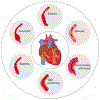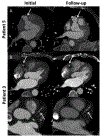IgG4-related disease as a variable-vessel vasculitis: A case series of 13 patients with medium-sized coronary artery involvement
- PMID: 36848823
- PMCID: PMC10148901
- DOI: 10.1016/j.semarthrit.2023.152184
IgG4-related disease as a variable-vessel vasculitis: A case series of 13 patients with medium-sized coronary artery involvement
Abstract
Introduction: IgG4-related disease (IgG4-RD) is a systemic autoimmune fibroinflammatory disease that can affect multiple organ systems. Although large-vessel vasculitis is a well-recognized manifestation of IgG4-RD, this condition is generally not regarded as a vasculitis. We aimed to describe coronary artery involvement (CAI), a vascular distribution about which little is known in IgG4-RD.
Material and methods: Patients with IgG4-related CAI were identified from a large, prospective IgG4-RD cohort. CAI was confirmed by imaging evidence of arterial or periarterial inflammation in any coronary artery. We extracted details regarding demographics, features of IgG4-RD, and manifestations of CAI.
Results: Of 361 cases in the cohort, 13 (4%) patients had IgG4-related CAI. All were male and all had highly-elevated serum IgG4 concentrations, with a median value of 955 mg/dL (interquartile range [IQR]: 510-1568 mg/dL; reference: 4-86 mg/dL). Median disease duration at the time of CAI diagnosis was 11 years (IQR: 8.23-15.5 years). Extensive disease in the coronary arteries was the rule: all three major coronary arteries were involved in 11 patients (85%). The coronary artery manifestations included wall thickening or periarterial soft tissue encasement (85%), stenosis (69%), calcification (69%), and aneurysms or ectasia (62%). Five patients (38%) had myocardial infarctions, 2 (15%) required coronary artery bypass grafting, and 2 (15%) developed ischemic cardiomyopathy.
Discussion: Coronary arteritis and periarteritis are important manifestations of IgG4-RD, which should be regarded as a variable-vessel vasculitis that is among the most diverse forms of vasculitis known. Potential complications of CAI include coronary artery aneurysms, myocardial infarction, and ischemic cardiomyopathy.
Keywords: Coronary arteritis; IgG4-related disease; Variable-vessel vasculitis; Vasculitis.
Copyright © 2023 Elsevier Inc. All rights reserved.
Figures






References
-
- Sato M, Honda A, Yamamoto T. Hypocomplementemic cutaneous small vessel vasculitis in a patient with IgG4-related disease. Dermatol Online J 2020;26:13030/qt4dg0x6rk. - PubMed
Publication types
MeSH terms
Substances
Grants and funding
LinkOut - more resources
Full Text Sources
Medical
Miscellaneous

